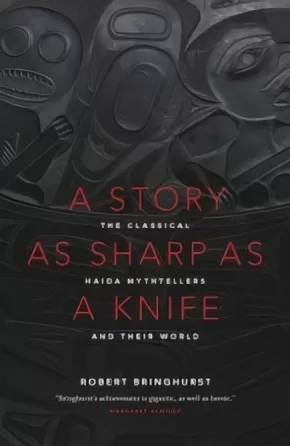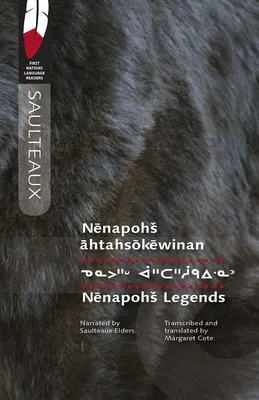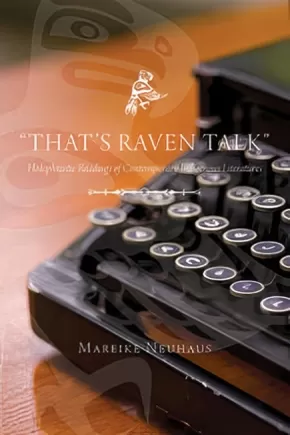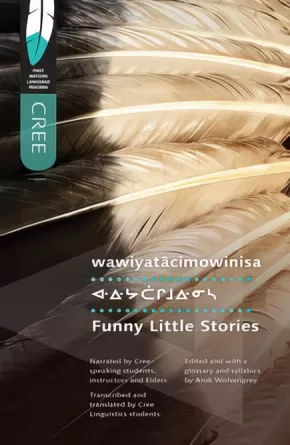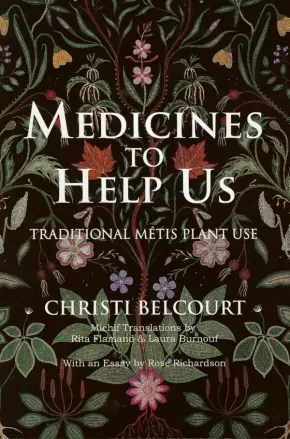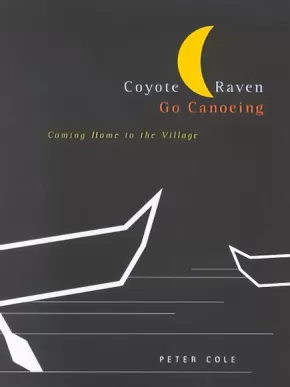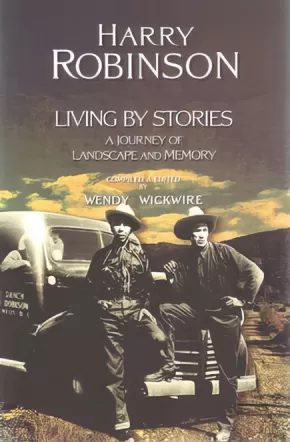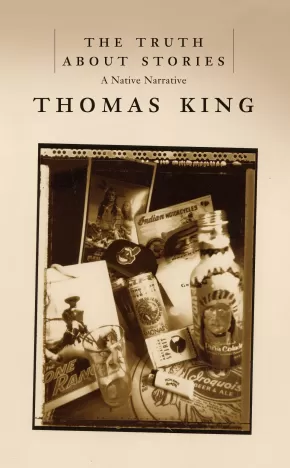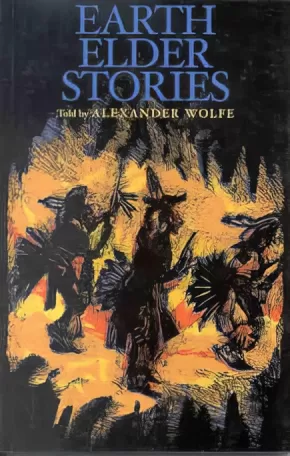
Indigenous Languages
106
-
115
of
115 Results;
Sort By
Go To
of 8
A Story as Sharp as a Knife
$28.95
Format:
Paperback
Text Content Territories:
Indigenous Canadian; First Nations; Haida;
ISBN / Barcode: 9781553658399
Synopsis:
Synopsis:
A seminal collection of Haida myths and legends; now in a gorgeous new package.
The linguist and ethnographer John Swanton took dictation from the last great Haida-speaking storytellers, poets and historians from the fall of 1900 through the summer of 1901. Together they created a great treasury of Haida oral literature in written form.
Having worked for many years with these century-old manuscripts, linguist and poet Robert Bringhurst brings both rigorous scholarship and a literary voice to the English translation of John Swanton's careful work. He sets the stories in a rich context that reaches out to dozens of native oral literatures and to myth-telling traditions around the globe.
Attractively redesigned, this collection of First Nations oral literature is an important cultural record for future generations of Haida, scholars and other interested readers. It won the Edward Sapir Prize, awarded by the Society for Linguistic Anthropology, and it was chosen as the Literary Editor's Book of the Year by the Times of London.
Bringhurst brings these works to life in the English language and sets them in a context just as rich as the stories themselves one that reaches out to dozens of Native American oral literatures, and to mythtelling traditions around the world.
Dancing on Our Turtle's Back
$24.95
Format:
Paperback
Text Content Territories:
Indigenous Canadian;
ISBN / Barcode: 9781894037501
Synopsis:
Synopsis:
Many promote Reconciliation as a “new” way for Canada to relate to Indigenous Peoples. In Dancing on Our Turtle’s Back: Stories of Nishnaabeg Re-Creation, Resurgence, and a New Emergence activist, editor, and educator Leanne Simpson asserts reconciliation must be grounded in political resurgence and must support the regeneration of Indigenous languages, oral cultures, and traditions of governance.
Simpson explores philosophies and pathways of regeneration, resurgence, and a new emergence through the Nishnaabeg language, Creation Stories, walks with Elders and children, celebrations and protests, and meditations on these experiences. She stresses the importance of illuminating Indigenous intellectual traditions to transform their relationship to the Canadian state.
Challenging and original, Dancing on Our Turtle’s Back provides a valuable new perspective on the struggles of Indigenous Peoples.
Additional Information
168 pages | 5.50" x 8.50" | Paperback
Nenapohs Legends
$19.95
Format:
Paperback
Text Content Territories:
Indigenous Canadian; First Nations; Anishinaabeg; Ojibway; Saulteaux;
Grade Levels: University/College;
ISBN / Barcode: 9780889772199
Synopsis:
Synopsis:
These seven tales are the traditional teaching stories of Nenapohs, the Saulteaux culture hero and trickster. Oral in origin, they have been passed on through generations by the traditional teachers, the Elders.
For the first time, they are published and made available in Nahkawewin or Saulteaux, the westernmost dialect of the Ojibwe language. Each story is illustrated and is presented in both Standard Roman Orthography and syllabics, with English translation. The book also includes a pronunciation guide and a Saulteaux-to-English glossary.
Educator & Series Information
Nenapohs Legends is part of the First Nations Language Readers series. With a mix of traditional and new stories, each First Nations Language Reader introduces an Indigenous language and demonstrates how each language is used today. The University of Regina Press’s long-term goal is to publish all 60+ Indigenous languages of Canada.
Additional Information
112 pages | 5.50" x 8.50" | Narrated by Saulteaux Elders, Transcribed and Translated by Margaret Cote
That's Raven Talk: Holophrastic Readings of Contemporary Indigenous Literatures
$34.95
Format:
Paperback
Text Content Territories:
Indigenous Canadian;
ISBN / Barcode: 9780889772335
Synopsis:
Synopsis:
“That’s Raven Talk”: Holophrastic Readings of Contemporary Indigenous Literatures is the first comprehensive study of North American Indigenous languages as the basis of textualized orality in Indigenous literatures in English. Drawing on a significant Indigenous language structure—the holophrase (one-word sentence)— Neuhaus proposes “holophrastic reading” as a culturally specific reading strategy for orality in Indigenous writing. In readings of works by Ishmael Alunik (Inuvialuit), Alootook Ipellie (Inuit), Richard Van Camp (Dogrib), Thomas King (Cherokee), and Louise Bernice Halfe (Cree), she demonstrates that (para)holophrases—the various transformations of holophrases into English-language discourse—textualize orality in Indigenous literatures by grounding it in Indigenous linguistic traditions. Neuhaus’s discussion points to the paraholophrase, the functional equivalent of the holophrase, as a central discourse device in Indigenous writing and as a figure of speech in its own right. Building on interdisciplinary research, this groundbreaking study not only links oral strategies in Indigenous writing to Indigenous rhetorical sovereignty, but also points to ancestral language influences and Indigenous rhetoric more generally as areas for future research.
Additional Information
336 pages | 6.00" x 9.00"| Paperback
Funny Little Stories / wawiyatacimowinisa (1 in stock, in reprint)
$12.95
Editors:
Format:
Paperback
Text Content Territories:
Indigenous Canadian; First Nations; Cree (Nehiyawak); Plains Cree; Swampy Cree ; Woodland Cree;
ISBN / Barcode: 9780889771857
Synopsis:
Synopsis:
This is the first in a series of readers in the First Nations languages of the prairie provinces meant for language learners and language users. The stories in this volume come from a variety of sources, all being narrated or written by fluent speakers of Cree, whether students or instructors of the Cree language or Elders. Funny Little Stories is a collection of nine stories representing the Plains Cree, Woods Cree, and Swampy Cree dialects, with a pronunciation guide and a Cree-to-English glossary.
Students and Elders come together in this volume to offer samples of three distinct genres of Cree storytelling: word play, humorous accounts of life experiences, and traditional stories about Wisahkecahk, the trickster-hero.
Each story is illustrated and is presented in both Standard Roman Orthography and syllabics, with English translation.
Educator & Series Information
Funny Little Stories is part of the First Nations Language Readers series. With a mix of traditional and new stories, each First Nations Language Reader introduces an Indigenous language and demonstrates how each language is used today. The University of Regina Press’s long-term goal is to publish all 60+ Indigenous languages of Canada.
Additional Information
110 pages | 5.50" x 8.50" | Narrated by Cree-speaking students, instructors, and Elders | Transcribed and Translated by Cree Linguistics Students | Edited and with a glossary and syllabics by Arok Wolvengrey
Authenticity Note: Because of the contribution of Indigenous Peoples, such as Cree-speaking Elders, to this work on Cree storytelling, it has received the Authentic Indigenous Text label.
Medicines to Help Us: Traditional Métis Plant Use
$25.00
Artists:
Text Content Territories:
Indigenous Canadian; Métis;
ISBN / Barcode: 9780920915790B
Synopsis:
Synopsis:
Based on Métis artist Christi Belcourt’s painting “Medicines to Help Us,” this innovative and vibrant resource honours the centuries-old healing traditions of Métis women. With contributions from Métis Elders Rose Richardson and Olive Whitford, as well as key Michif phrases and terminology, Medicines to Help Us is the most accessible resource relating to Métis healing traditions produced to date.
Educator Information
This resource guide does not include the study prints referred to on the back cover and within the book.
Michif Translators: Laura Burnoff and Rita Flamand
Elder Validation: Rose Richardson
Format: Book Only - English, with plant names in Michif, Nehiyawewin (Cree), and Anishinaabemowin (Ojibway)
Coyote and Raven Go Canoeing: Coming Home to the Village (2 in stock) - ON SALE
$22.00 $32.95
Format:
Paperback
Text Content Territories:
Indigenous;
Grade Levels: University/College;
ISBN / Barcode: 9780773529137
Synopsis:
Synopsis:
A lyrical, epic narrative about Aboriginal knowledge and education.
we are narrators narratives voices interlocutors of our own knowings
we can determine for ourselves what our educational needs are
before the coming of churches residential schools prisons
before we knew how we knew we knew
In a gesture toward traditional First Nations orality, Peter Cole blends poetic and dramatic voices with storytelling. A conversation between two tricksters, Coyote and Raven, and the colonized and the colonizers, his narrative takes the form of a canoe journey. Cole draws on traditional Aboriginal knowledge to move away from the western genres that have long contained, shaped, and determined ab/originality. Written in free verse, Coyote and Raven Go Canoeing is meant to be read aloud and breaks new ground by making orality the foundation of its scholarship.
Cole moves beyond the rhetoric and presumption of white academic (de/re)colonizers to aboriginal spaces recreated by aboriginal peoples. Rather than employing the traditional western practice of gathering information about exoticized other, demonized other, contained other, Coyote and Raven Go Canoeing is a celebration of aboriginal thought, spirituality, and practice, a sharing of lived experience as First Peoples.
Reviews
"One of the clearest and most thorough pictures of an aboriginal view of the consequences of colonization that I have ever read."— Olive Dickason, emeritus, York University
"In the tradition of Gayatri Spivak, Homi Bhabha, Edward Said, Trinh Min-Ha, and other radically original intellectuals, Cole risks a new language to talk about the unthinkable."— Mary Bryson, Department of Educational and Counselling Psychology, University of British Columbia
Additional Information
352 pages | 7.00" x 9.50"
Harry Robinson: Living by Stories: A Journey of Landscape and Memory
$24.95
Editors:
Format:
Paperback
Text Content Territories:
Indigenous Canadian; First Nations; Salish; Interior Salish; Syilx (Okanagan); Similkameen (Smelqmix);
Grade Levels: University/College;
ISBN / Barcode: 9780889225220
Synopsis:
Synopsis:
Following on two previous collections— Write It on Your Heart: The Epic World of an Okanagan Storyteller (1989) and Nature Power: In the Spirit of an Okanagan Storyteller (2004)—Living by Stories is the third volume of oral narratives by Okanagan storyteller Harry Robinson. This third collection documents how the arrival of whites forever altered the Salish cultural landscape.
Living by Stories includes a number of classic stories set in the “mythological age” about the trickster/transformer, Coyote, and his efforts to rid the world of bad people— spatla or “monsters,” but this new volume is more important for its presentation of historical narratives set in the more recent past. As with the mythological accounts, there is much chaos and conflict in these stories, mainly due to the arrival of new quasi-monsters—“SHAmas” (Whites)—who dispossess “Indians” of their lands and rights, impose new political and legal systems, and erect roads, rail lines, mines, farms, ranches and towns on the landscape.
With permission from Harry Robinson, Wendy Wickwire began recording Robinson's oral stories in 1977. Robinson took his role as a storyteller very seriously and worried about the survival of the oral tradition and his stories. “I’m going to disappear”, he told one reporter, “and there’ll be no more telling stories.”
Review
Whenever I need to be reminded that language is magic and that stories can change the world, I go to Robinson.
- Thomas King
Additional Information
288 pages | 6.00" x 9.00"
Stories from Harry Robinson
Edited and compiled by Wendy Wickwire
The Truth About Stories: A Native Narrative
$19.99
Format:
Paperback
Text Content Territories:
Indigenous American; Indigenous Canadian;
ISBN / Barcode: 9780887846960
Synopsis:
Synopsis:
"Stories are wondrous things," award-winning author and scholar Thomas King declares in his 2003 CBC Massey Lectures. "And they are dangerous." In his 2003 Massey lectures, award-winning author and scholar Thomas King looks at the breadth and depth of Native experience and imagination.
Beginning with a traditional Native oral story, King weaves his way through literature and history, religion and politics, popular culture and social protest, gracefully elucidating North America's relationship with its Native peoples.
Native culture has deep ties to storytelling, and yet no other North American culture has been the subject of more erroneous stories. The Indian of fact, as King says, bears little resemblance to the literary Indian, the dying Indian, the construct so powerfully and often destructively projected by White North America. With keen perception and wit, King illustrates that stories are the key to, and only hope for, human understanding. He compels us to listen well.
Reviews
"Trust a novelist and English professor to get to the heart of how stories and storytelling shape our perceptions. This is a wonderful study of the power of words." — Booklist
"A collection of thought-provoking essays examining the importance of the oral tradition. Storyteller Thomas King addresses Native cultural concerns and their primal link to storytelling. Intriguing and entertaining. Highly recommended for all tribal college collections and literature classes."— Tribal College Journal
"What is revealed in this graceful, even seductive book of essays about storytelling by the esteemed Cherokee novelist, radio personality, university professor, and Canadian émigré is that what is as important as the stories we tell about the world are the ways in which we interpret those stories." — World Literature in Review
"King’s addresses artfully combine literary and cultural criticism, traditional Native American stories, and personal experience." — The Bloomsbury Review
Educator Information
Essay series that is a study of First Peoples' storytelling in North America.
Grades 10-12 English First Peoples Resource for various units.
Curriculum Connections: English, Indigenous Studies, Civics and Careers, History, Humanities and Social Sciences.
Additional Information
208 pages | 5.08" x 8.00"
Earth Elder Stories
$14.95
Format:
Paperback
Text Content Territories:
Indigenous Canadian; First Nations; Anishinaabeg; Ojibway; Saulteaux;
ISBN / Barcode: 9780920079355
Synopsis:
Synopsis:
Alexander Wolfe is a Saulteaux/Ojibwa storyteller and the keeper of his family's oral history. These stories belong to his family and include accounts of how the descendents of Pinayzitt, a Saulteaux leader who lived in the Northwest Territories of Canada and the Great Plains of the United States in the 1800s, lived on the land, survived the smallpox and flu epidemics, signed treaties, and were confined to reservations.
The stories blend history with legend and prophecy, giving both the equal weight they occupy in Native oral tradition. In their retelling, Wolfe carries out his responsibility of passing on his family's stories to the next generation, as well as encouraging Natives to record their histories and non-Natives to understand the significance and lessons of these tales.
Earth Elder Stories has proven an excellent resource for students of Native Studies, history, linguistics, and literature.
Sort By
Go To
of 8

